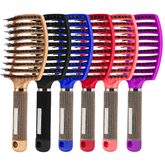5 reasons your hair might be falling out now — and what to do
Many people notice more hair on their brush, in the shower or on their clothes as the seasons change. While seeing extra shedding can be alarming, there are several common, often reversible reasons behind it. Dermatologists and hair specialists say a combination of seasonal cycles, environmental factors and health or lifestyle issues can all play a part. Below are five frequent causes and practical steps to take if your hair feels thinner than usual.
Five common reasons for increased hair fall
Hair loss is rarely down to a single factor. Here are the most commonly reported causes people and clinicians see in autumn and winter:
- Seasonal shedding (telogen effluvium): Hair grows in cycles. A larger than usual number of hairs can enter the resting phase and fall out a few months later, often after an identifiable trigger such as illness, significant stress or a change in season.
- Dry air and breakage: Colder months bring lower humidity and central heating, which can dry out hair and make it brittle. Breakage at the shaft is sometimes mistaken for true hair loss from the root.
- Changes in haircare and styling: Increased use of hot styling tools, tighter hairstyles or harsh chemical treatments can weaken hair and increase shedding.
- Nutritional and health-related causes: Deficiencies (for example iron or vitamin D), thyroid problems and certain medications are all known to affect hair growth. In many cases these are treatable once identified.
- Stress and life events: Physical or emotional stress—such as illness, surgery, childbirth or a period of high anxiety—can prompt noticeable shedding several weeks or months later.
How to tell if it’s temporary or needs medical attention
Not all increased shedding warrants alarm. Simple checks can help you decide whether to wait and monitor or seek professional advice:
- Is the hair falling out from the root (you can usually see a tiny bulb) or is it breaking along the shaft? Breakage often points to styling or dryness rather than true loss of follicles.
- Is the shedding sudden and heavy, or gradual? Sudden, large-scale shedding suggests telogen effluvium and often follows a trigger; gradual widening of the parting or a receding hairline may indicate patterned hair loss.
- Are there other symptoms such as weight changes, fatigue, dry skin or nail changes? Those could point to an underlying health issue like thyroid dysfunction or nutrient deficiency.
Practical steps you can take now
If you are noticing more hair on your clothes or in the plughole, there are straightforward measures that can reduce breakage and support overall scalp health:
- Use gentle haircare: switch to a mild shampoo and a nourishing conditioner, avoid daily washing if your scalp tolerates it, and be gentle when detangling—use a wide-tooth comb and start at the ends.
- Limit heat and chemical exposure: reduce the frequency of hot styling tools, lower heat settings, and space out chemical treatments such as bleaching or straightening.
- Protect from the elements: cover hair with a hat or scarf in cold, windy weather to reduce moisture loss, and consider a leave-in conditioner or oil to help retain hydration.
- Review diet and supplements: ensure adequate protein intake and a balanced diet rich in iron, vitamin D and other micronutrients. Avoid high-dose supplements without medical advice.
- Manage stress: practical stress-reduction techniques—sleep, exercise, mindfulness or talking therapies—can help, particularly when shedding follows a stressful period.
If you suspect an underlying medical reason, book an appointment with your GP. Basic blood tests can check for thyroid function, iron levels and other common causes. A GP may refer you to a dermatologist or trichologist if specialized assessment is needed.
Takeaway
Noticing more hair shedding can be distressing, but in most cases it is not permanent. Seasonal factors, environmental dryness, styling habits and common health issues are frequent culprits and are often manageable or reversible. The sensible first steps are to adopt gentler haircare, protect your hair from cold and heat, check your diet and lifestyle, and consult a GP if you have other symptoms or rapid, heavy shedding. Early assessment can rule out treatable medical causes and help you regain confidence in your hair’s recovery.







